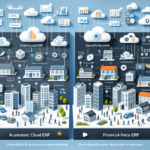How to Connect, Optimize, and Manage DHL eCommerce for FinancialForce ERP
The integration of DHL eCommerce with FinancialForce ERP can bring significant benefits to your business, including improved order fulfillment and shipping, streamlined inventory management, and enhanced efficiency. However, to maximize these benefits, it is essential to understand the key features of the integration, best practices for optimization, and common challenges with their solutions. In this comprehensive guide, we explore how to connect, optimize, and manage your DHL eCommerce and FinancialForce ERP integration effectively.
Understanding the Benefits of Integrating DHL eCommerce with FinancialForce ERP
Integrating DHL eCommerce with FinancialForce ERP provides access to a suite of powerful features and capabilities that foster business growth and enhance customer satisfaction. According to a Forrester Report, businesses implementing ERP integrations experience a 35% improvement in operational efficiency and a 25% reduction in fulfillment errors.
- Streamlined Order Fulfillment and Shipping: Automate order processing to reduce delivery times and improve accuracy.
- Optimal Inventory Management: Real-time tracking of stock levels and automated reorder management ensure inventory optimization.
- Maximized Efficiency: Automate key business processes, reducing manual labor and minimizing errors.
- Enhanced Customer Satisfaction: Faster delivery times, accurate tracking information, and transparent order management lead to higher customer satisfaction.
Setting Up DHL eCommerce Integration with FinancialForce ERP
Establishing the integration between DHL eCommerce and FinancialForce ERP involves several key steps. This step-by-step guide ensures a smooth and effective setup process:
- Identify Integration Requirements and Goals: Determine your business needs and choose the integration options that best align with your objectives.
- Select an Integration Platform: Choose a platform that supports DHL eCommerce and FinancialForce ERP integration, such as Celigo or DBSync.
- Configure the Integration Platform: Set up the platform with both DHL eCommerce and FinancialForce ERP by providing necessary authentication keys and API access.
- Map Your Data Fields: Ensure accurate data transfer between systems by correctly mapping data fields.
- Test the Integration: Conduct thorough testing to verify seamless data flow and adherence to all business rules.
- Launch and Monitor the Integration: Deploy the integration and monitor its performance to ensure optimal operation and quickly address any issues.
Optimizing Your DHL eCommerce-FinancialForce ERP Integration
Post-setup optimization is crucial to fully leverage the integration's potential. Implement the following best practices to fine-tune your integration:
- Regularly Review Data Mapping and Business Rules: Ensure alignment with your evolving business needs by periodically refining data mappings and business rules.
- Monitor Key Performance Metrics: Track metrics such as order processing time, shipping accuracy, and inventory turnover to assess integration performance.
- Automate Processes: Minimize manual interventions by automating as many processes as possible, reducing labor costs and error rates.
- Integrate Additional Systems: Connect with other third-party systems like accounting software or marketing automation platforms to enhance operational efficiency.
Key Features of DHL eCommerce Integration with FinancialForce ERP
The DHL eCommerce and FinancialForce ERP integration offers a robust set of features designed to streamline business operations:
- Automated Order Fulfillment and Shipping: Automates the entire order fulfillment process, including shipping label generation and real-time tracking.
- Streamlined Inventory Management: Provides real-time visibility into stock levels and automates reorder processes to prevent stockouts or overstocking.
- Seamless Data Communication: Ensures accurate and timely data exchange between DHL eCommerce and FinancialForce ERP.
- Flexible Customization: Allows businesses to tailor the integration to meet specific operational requirements.
Managing and Monitoring Your DHL eCommerce-FinancialForce ERP Integration
Effective management and monitoring are essential for maintaining integration performance and identifying issues proactively. Implement the following strategies:
- Establish Key Performance Metrics: Define metrics such as order processing time, shipping accuracy, and inventory turnover to track integration performance.
- Set Up Automated Alerts: Configure alerts and notifications to detect and address issues promptly.
- Regularly Review Data Mapping and Business Rules: Periodically ensure that data mapping and business rules align with current business needs.
- Collaborate with Your Integration Provider: Maintain a strong partnership with your integration provider to resolve issues swiftly and optimize integration performance.
Common Challenges and Solutions in Integrating DHL eCommerce with FinancialForce ERP
While integrating DHL eCommerce with FinancialForce ERP offers numerous benefits, it also presents certain challenges. Understanding these challenges and implementing effective solutions can ensure a successful integration:
- Complex Data Mapping: Mapping data fields accurately between systems can be intricate. Solution: Collaborate closely with your integration provider to ensure precise data transfer.
- API Limitations: Restrictions on data transfer volumes can affect integration performance. Solution: Optimize data mapping and system configurations to minimize data transfer requirements.
- Changing Business Requirements: Evolving business needs may necessitate adjustments to the integration. Solution: Continuously monitor and refine your integration to accommodate changing requirements.
Advanced Topics in DHL eCommerce-FinancialForce ERP Integration
Streamlining Inventory Management
The integration significantly enhances inventory management by providing real-time tracking and automated reorder processes:
- Automated Stock Level Tracking: Keeps an accurate record of inventory levels, preventing stockouts and overstocking.
- Automated Reorder Management: Streamlines the reorder process based on real-time inventory data.
- Real-Time Data Access: Facilitates informed decision-making regarding stock levels and order fulfillment.
- Seamless Data Communication: Ensures accurate data flow between systems, reducing errors.
Leveraging Integration for Competitive Advantage
Utilize the integration to gain a competitive edge by enhancing efficiency, customer satisfaction, and business growth:
- Continuous Optimization: Regularly refine the integration to meet evolving business needs.
- Highlighting Operational Efficiency: Showcase your efficient order fulfillment and shipping processes to attract and retain customers.
- Personalized Customer Experiences: Use real-time tracking and seamless communication to offer transparent and tailored customer interactions.
- Investment in Growth Initiatives: Allocate efficiency gains and cost savings towards initiatives like product development and marketing expansion.
Maximizing ROI through Improved Efficiency
The integration helps maximize return on investment (ROI) by enhancing operational efficiency and reducing costs:
- Automation of Business Processes: Reduces labor costs and increases productivity.
- Performance Tracking: Monitor metrics such as order processing times and inventory turnover to identify efficiency improvements.
- Lean Operations: Incorporate lean principles to streamline operations and minimize waste.
- Continuous Integration Optimization: Regularly update integration configurations and data mappings to maintain optimal performance.
Exploring Customization Options
Tailor the integration to match your unique business needs through various customization options:
- Customizable Data Mapping: Align data fields between DHL eCommerce and FinancialForce ERP based on your specific requirements.
- Flexible Business Rules: Configure business rules that reflect your operational strategies.
- Custom Alerts and Notifications: Set up tailored alerts to stay informed about key processes and potential issues.
- Flexible Integration Scheduling: Schedule integration tasks according to your business workflows and priorities.
Scaling Your Business with the Integration
Use the integration as a foundation for scaling your business operations effectively:
- Continuous Optimization: Ensure the integration scales with your business by regularly refining it to meet larger operational demands.
- Investment in Growth: Allocate resources saved through efficiency gains towards business expansion initiatives.
- Expansion into New Markets: Utilize real-time data and efficient processes to support entry into new geographic regions.
- Performance Monitoring: Keep track of key metrics to ensure the integration scales seamlessly with your growth.
Common Mistakes to Avoid
Avoiding common pitfalls can enhance the success of your integration project:
- Underestimating Integration Complexity: Failing to recognize the intricacies of integration can lead to errors and performance issues.
- Assuming "Set It and Forget It": Neglecting ongoing monitoring and optimization can result in diminishing integration performance.
- Insufficient Support Investment: Not allocating adequate resources for support and expertise can delay achieving optimal results.
- Misaligned Configuration and Data Mapping: Ensuring alignment between integration settings and business needs is crucial for efficiency.
Future Trends and Opportunities in DHL eCommerce-FinancialForce ERP Integration
The integration landscape is continuously evolving, influenced by technological advancements and shifting market demands. Key trends and opportunities to watch include:
- AI and Machine Learning Integration: Incorporate AI-driven insights to further automate and streamline processes like order processing and inventory management.
- Support for New Delivery Channels: Expand integration capabilities to accommodate multi-courier and hyperlocal delivery options.
- Enhanced Real-Time Tracking: Improve shipping visibility and transparency with advanced real-time tracking technologies.
- Geographic and Service Expansion: Leverage integration to enter new markets and offer enhanced service options to meet diverse customer needs.
By staying abreast of these trends and leveraging emerging opportunities, your business can maintain a competitive edge and capitalize on new growth avenues as they arise.






















